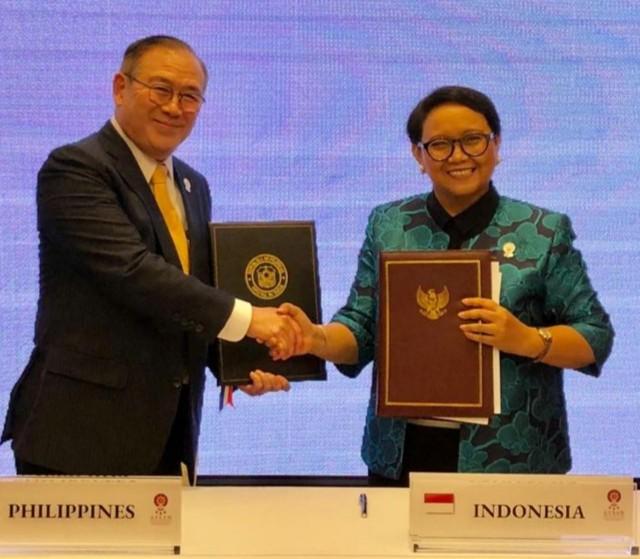Historic PHL-Indonesia maritime border treaty enters into force

The historic maritime boundary agreement between the Philippines and Indonesia, which delineates their overlapping Exclusive Economic Zones (EEZ), finally entered into force on Thursday more than two decades since it was first discussed by the two Southeast Asian nations.
Foreign Affairs Secretary Teodoro Locsin, Jr. and Indonesian Foreign Minister Retno Marsudi signed the Protocols of Exchange of the instruments of ratification concerning the delimitation of the EEZ between the two countries at the sidelines of the ongoing 52nd Association of South East Asian Nations ministerial meeting in Bangkok, Thailand.
"The agreement is expected to benefit both countries, economically and politically, by promoting more bilateral cooperation in the EEZ in order to advance the common interest of managing and preserving the resources in the EEZ and further strengthening maritime security cooperation between the two countries," said the DFA in a statement.
Such pact can serve as a model among states with overlapping economic zones to resolve their disputes in accordance to international law, such as the United Nations Convention on the Law of the Sea (UNCLOS).
The Philippines, Vietnam, Malaysia, Brunei, China and Taiwan are embroiled in decades- long territorial rift in the resource-rich South China Sea, particularly in its southern part, called the Spratlys.
China insists it has historic rights over the waters where huge minerals, natural oil and gas deposits have been discovered in several areas.
In 2016, an international tribunal in The Hague, Netherlands invalidated China’s claim. However, Beijing refused to recognize the ruling.
The agreement between the Philippines and Indonesia was first discussed in June 1994. It was formally signed by the two countries on May 23, 2014 in Manila and was ratified by President Rodrigo Duterte on February 15, 2017 and by the Indonesian Parliament on April 27, 2017. The Philippine Senate voted unanimously to adopt the accord on June 3, 2019.
Wide overlaps in the EEZ of the Philippines and Indonesia, which run across the Mindanao Sea and Celebes Sea, and in the southern section of the Philippine Sea in the Pacific Ocean, required the two countries to negotiate and agree on a shared boundary.
The Philippines and Indonesia, the two largest archipelagic states in the world, are parties to the 1982 UNCLOS and are entitled to an EEZ of 200 nautical miles.
An EEZ covers 200 nautical miles from a coastal nation's shores and grants them the right to explore, manage and exploit resources, as well as undersea oil and gas deposits within the area under the UN maritime convention. — BAP, GMA News




